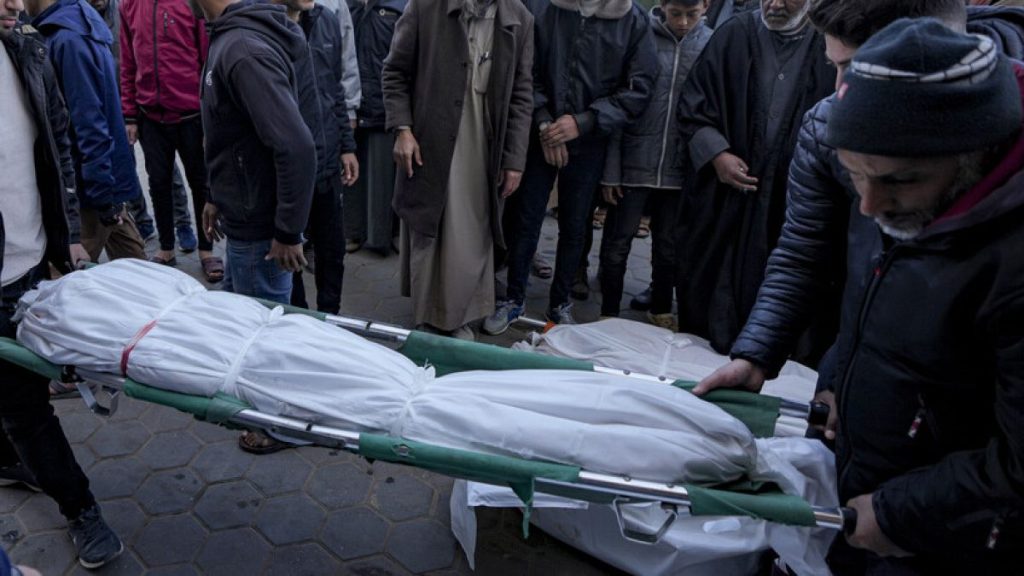The Gaza Strip continues to be a scene of devastation as Israeli airstrikes persist, claiming the lives of at least 17 more Palestinians on Tuesday, according to the Hamas-run Gaza Health Ministry. The strikes targeted residential areas, with one attack on a house in Deir al-Balah resulting in 11 fatalities. Another airstrike in the densely populated Nuseirat refugee camp killed six and injured seven. These attacks come amidst reports of ongoing negotiations between Israel and Hamas, mediated by the United States, Qatar, and Egypt, with the aim of establishing a ceasefire and securing the release of dozens of hostages currently held in Gaza. The current conflict, sparked by a Hamas attack on southern Israel on October 7, 2023, has resulted in the deaths of over 1,200 people in Israel and the abduction of approximately 250, with around 100 hostages still believed to be in Gaza. While a third of these hostages are feared dead, the possibility of a ceasefire agreement offers a glimmer of hope for their remaining families.
Despite the ongoing violence, reports suggest that a ceasefire agreement might be within reach. Two officials involved in the negotiations disclosed to the Associated Press that Hamas has accepted a draft agreement for a ceasefire and the release of hostages. While an Israeli official confirmed progress, they cautioned that the details remain under negotiation. U.S. National Security Adviser Jake Sullivan expressed optimism, stating that a deal could be finalized within the week. This potential breakthrough comes after more than a year of intense diplomatic efforts to find a resolution to the ongoing conflict. The war, which began 15 months ago, has already claimed the lives of over 46,000 Palestinians, with a significant portion of the victims being women and children, according to the Gaza Health Ministry.
The proposed ceasefire agreement, structured in phases, draws inspiration from a framework presented by US President Joe Biden in May. The initial phase focuses on the release of the most vulnerable hostages – women, children, and female soldiers – currently held by Hamas in Gaza. In return, a temporary cessation of hostilities would be implemented. Subsequent phases would address the release of the remaining hostages in exchange for the release of approximately 1,000 Palestinian prisoners held by Israel, the withdrawal of Israeli forces from Gaza, and the establishment of a lasting ceasefire. Israeli Prime Minister Benjamin Netanyahu has indicated a commitment to the initial phase, focusing on the partial hostage release in exchange for a temporary halt in fighting, with the longer-term ceasefire to be negotiated subsequently.
Currently, negotiations are reportedly at an advanced stage for the release of 33 out of the estimated 98 women, children, and female soldiers held hostage. This first phase would also potentially allow some displaced Palestinians to return to their homes. The subsequent phase, involving the release of remaining hostages and a prisoner exchange, hinges on further negotiations during the initial ceasefire period. Key sticking points, such as the extent of Israeli troop withdrawal, continue to be debated. While Hamas has insisted on the withdrawal of Israeli troops as a prerequisite for the complete release of hostages, Netanyahu has publicly committed to fighting until achieving “total victory” over Hamas. The hope is that a temporary cessation of hostilities will create an environment conducive to resolving these complex issues.
Despite the cautious optimism surrounding these developments, it is important to acknowledge the past challenges in reaching a durable agreement. Previous attempts at brokering a ceasefire have repeatedly stalled, highlighting the deep-seated mistrust and complex political realities at play. The details of the withdrawal of Israeli troops and the exchange of hostages for Palestinian prisoners remain contentious issues. Hamas’s demand for troop withdrawal as a precondition for the release of all hostages clashes with Netanyahu’s stated goal of complete victory, underscoring the formidable obstacles that negotiators face. The success of the current talks hinges on the willingness of both sides to compromise and find common ground.
While reports suggest significant progress, previous instances of optimistic pronouncements followed by stalled negotiations underscore the fragility of the situation. The successful implementation of a ceasefire and hostage release will require navigating complex political and security concerns, and ultimately, the cooperation of both Hamas and Israel. The international community, particularly the US, Qatar, and Egypt, continues to play a crucial role in mediating the negotiations and fostering an environment where a lasting peace can be achieved. The ongoing violence and the immense human cost underscore the urgency of finding a sustainable solution to the protracted conflict. The hope is that this current push for a ceasefire will mark a turning point towards a more peaceful future for both Israelis and Palestinians.














